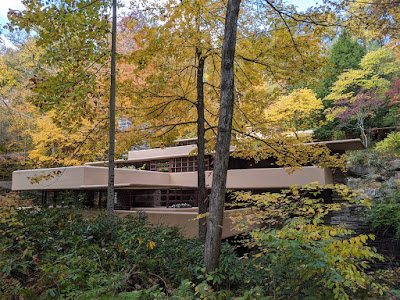Fallingwater has long been high on our list of American architectural sites to visit, not least because of its fame but also because of our liking for the effective integration of the natural and the built. Frank Lloyd Wright designed the house in 1935, a summer get-away, for the Kaufmann family, owners of Pittsburgh's largest department store (remember those?). FLW over his long career designed hundreds of structures, many of them individual homes, and they are all over the globe. But Fallingwater is relatively unique: not only does it most superbly express his "organic" philosophy of integrating the natural and the built, but it is also the only instance where the interiors, furniture, etc., that he designed for the house remain and are on view in their intended setting. Alas, 2020 was not the best year to visit Fallingwater. Because of the plague, only outside tours and viewing were permitted. But one could look in through the windows and get a sense of the thing. And the outside, over-all view, especially in this year's extraordinary fall color, is certainly the best for appreciating the house in its setting. Although located in Mill Run, PA, it is anything but run of the mill. Much of Vicki's childhood was spent in western Pennsylvania.
 |
Entry to the reception/visitor center
|
 |
The glorious autumn color continues
|
 |
Initial view of Fallingwater
|
 |
The creek
|
 |
Peering into the main living area
|
 |
The FLW-designed garage and servants' quarters (up the hill)
|
 |
| One of America's relatively few World Heritage sites |
 |
Ablution pool; the extensive stone work is all
from a local quarry and done by local workers |
 |
Another view
|
 |
Fallingplaster: like any great historical building, Fallingwater
requires continuing upkeep |
 |
Guest quarters
|
 |
Swimming pool
|
 |
Iconic view
|
 |
There are many wonderful websites on Fallingwater: begin
with https://fallingwater.org; if you visit, we'd certainly
recommend going on one of the guided tours |
















No comments:
Post a Comment